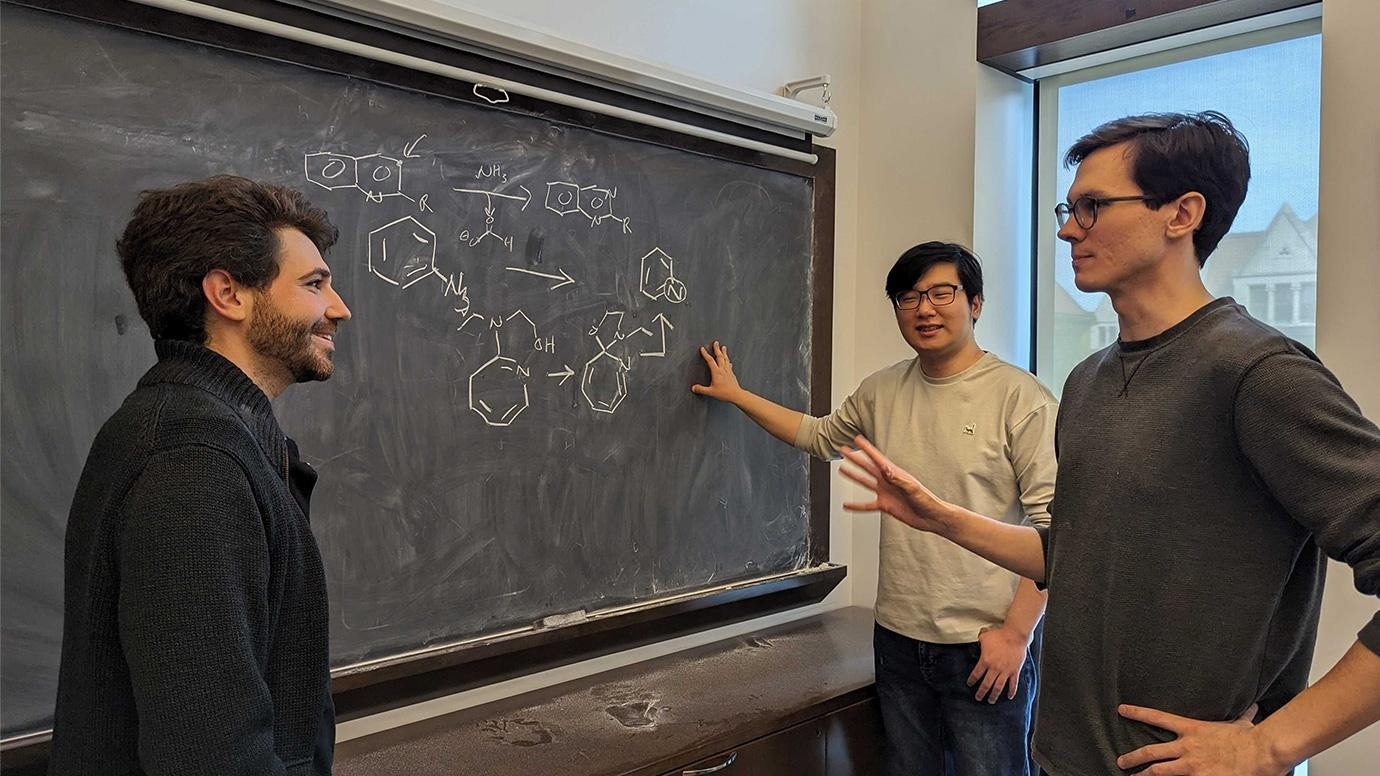Reviewed by Danielle Ellis, B.Sc.Nov 2 2023
For years, the top desire among those engaged in the development of pharmaceutical drugs was to find a simple method for substituting a carbon atom with a nitrogen atom in a molecule.
 From left: UChicago chemists Mark Levin, Jisoo Woo, and Tyler Pearson discuss techniques to swap nitrogen atoms in molecules—a change often made by drug discovery chemists. Image Credit: University of Chicago.
From left: UChicago chemists Mark Levin, Jisoo Woo, and Tyler Pearson discuss techniques to swap nitrogen atoms in molecules—a change often made by drug discovery chemists. Image Credit: University of Chicago.
However, two groundbreaking studies conducted by chemists at the University of Chicago and published in both Science and Nature now present two innovative approaches to fulfill this aspiration. These discoveries have the potential to streamline the process of creating novel medications.
This is the grand-challenge problem that I started my lab to try to solve. We haven’t totally solved it, but we’ve taken two really big bites out of the problem, and these findings lay a clear foundation for the future.”
Mark Levin, Study Senior Author and Associate Professor, Chemistry, University of Chicago
Body Swap
In chemistry, the substitution of a single atom within a molecule can yield a profound transformation.0252
By exchanging a carbon atom with a nitrogen atom, for instance, the drug molecule's interactions with its intended target can undergo a significant overhaul. This alteration may facilitate drug delivery to the brain or reduce the likelihood of unintended protein binding during its journey. Consequently, in the pursuit of crafting novel pharmaceutical drugs, scientists frequently seek to explore the replacement of specific atoms.
However, this attempt is far more complex in practice than in theory. The construction of a molecule is a meticulous, step-by-step process. Should one reach the final stages and then determine that a single atom substitution could enhance the drug’s efficacy, it necessitates returning to the outset and effectively reimagining the entire procedure.
“There’s a cost-benefit analysis that comes into play. Is it worth it to start over? Or do you just go with what you have?” explained Tyler Pearson, a Postdoctoral Researcher who is the first author of one of the studies.
Levin’s laboratory is dedicated to discovering innovative approaches for making subtle modifications to a molecule’s framework without requiring a complete restart of the process.
In this instance, their objective was to uncover a means of substituting a carbon atom with a nitrogen atom—a particular substitution that frequently arises in pharmaceutical chemistry. However, the currently available techniques for accomplishing this task have demonstrated restricted success.
You might accidentally delete the wrong carbon in the molecule, and this causes the rest of the molecule to shift. This can have a huge impact on how well the final molecule works.”
Jisoo Woo, Study First Author and Graduate Student, University of Chicago
The same principle that renders the alteration of a single atom potentially highly valuable also has a downside: If the reaction leads to even one unintended side effect, involving the displacement of a different atom, the molecule may lose its utility for its intended function.
To address this challenge, the laboratory devised two distinct yet mutually supportive strategies.
Remove the Right One
One of the approaches, as detailed in a Nature paper led by graduate student Jisoo Woo, focuses on molecules that already incorporate a nearby nitrogen atom within their structure.
This novel method involves the cleaving of the atom ring using ozone, and subsequently, it employs the first nitrogen molecule to effectively “guide” the insertion of the second nitrogen atom.
The other approach, as outlined in a Science paper led by Pearson, is designed for molecules lacking an inherent nitrogen atom. It simplifies the process by selectively removing a specific carbon atom and replacing it with a nitrogen atom.
While both methods are not flawless, according to the scientists, they represent a significant advancement where none existed previously. Levin emphasized that these techniques are valuable because they better align with the thought process of drug developers as they strive to create new medications.
Pearson added, “It’s a bit like typing on a computer instead of a typewriter. It’s much easier on a computer because it lets you write the way you think, which is not always linear.”
The scientists emphasized that both solutions relied on a degree of serendipity and ingenuity.
To me, this is a great example of the creativity that you need in order to make breakthroughs in chemistry. In both we had precipitating events that gave us a glimpse of something unusual, and that gave us a foothold we could work from.”
Mark Levin, Study Senior Author and Associate Professor, Chemistry, University of Chicago
Source:
Journal references:
Woo, J., et al. (2023) Carbon-to-nitrogen single-atom transmutation of azaarenes. Nature. doi.org/10.1038/s41586-023-06613-4.
Pearson, T. J., et al. (2023). Aromatic nitrogen scanning by ipso -selective nitrene internalization. Science. doi.org/10.1126/science.adj5331.